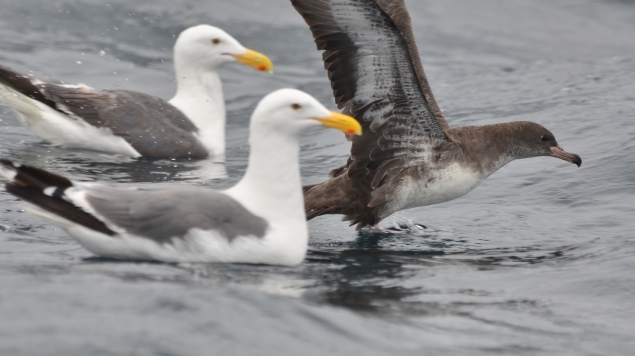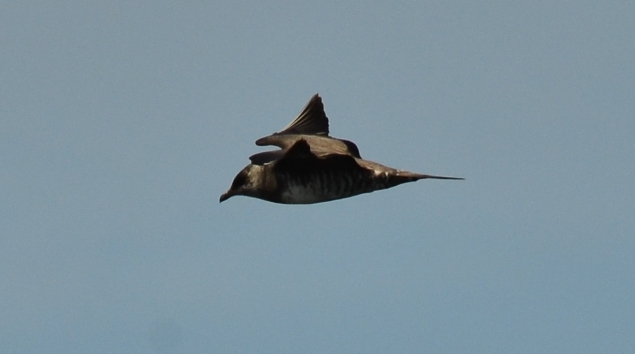Birding is hard. Quizzes are hard. I know. I applaud the bravery of the disturbingly few birders who submitted answers to
last month's quiz, whether publicly or in private. Birders, being nerds, often don't have much going for them outside the birding world, and so it is understandable that many tremble at the thought of publicly misidentifying a bird. If they wrap up their entire identity in their birding skills, and those skills are shown to be lacking...then what is the desperate birder left with? Nothing.
However, my wonderful readers, you have a precious resource available to you. You may have heard of it. It's called, "#7". Since I am, in fact, #7, let me offer you some advice...it's ok to be wrong. Believe it or not, I have been wrong...many times. It's fine. Let go of that horrible, putrid, nerdy arrogance, and allow yourself to be vulnerable. It's amazing what people can learn, with minds and hearts open wide. That's how you get to the next level. If a birder deludes himself/herself into thinking that they are the absolute shit (and most birds are definitively not that), then their capacity for soaking up and being able to use new information is severely diminished. I hope the next BB&B quiz gets more participation.

On to the quiz results. A few people guessed White-eyed Vireo for Quiz bird #1, but White-eyed typcially have more strongly-colored backs and yellower/greener secondaries. The vireo above was photographed on South Padre Island, TX, in the spring of this year. I am comfortable with identifying it as a Blue-headed Vireo, the expected "Solitary" Vireo there, from the drabbest end of the spectrum. The contrast with the throat and head is quite strong, as is the color in the flanks...otherwise, it looks very much like a Cassin's Vireo. The back is somewhere inbetween gray and yellow, and the head is certainly not any shade of blue. If this bird was found in California and submitted to the bird police as a Blue-headed Vireo, would it be accepted? I would wager it would not. That said, I feel a lot of west coast birders do not have a strong grasp of the variability Blue-headed can show...they tend to have their hands full with Cassin's vs. Plumbeous.
I would like to mention at this point how dissatisfied I am with how National Geographic Field Guide to Birds of North America (6th edish) treats the Solitary Vireo complex. For starters, the illustrations suck, and each species only gets one paltry, sucky illustration. On top of that, the web of ID problems these birds can present is not really addressed in the text. Blue-headed Vireos are alleged to have "yellow-tinged wing bars and tertials", when obviously that is not always the case (take a look at
this bird...or
this bird or
this bird). "Greenish yellow edges to dark secondaries", also listed as a Blue-headed field mark, is frequently found on Cassin's. I generally like the Natty Geo guide (it is the only book I've been recommending to other birders since the 90's), but the Solitary Vireo section needs some serious work.
Now, in the interest of embracing being Wrong, let me know if you have a convincing argument for this being a vagrant CAVI instead of BHVI. We can talk this out. The bird does sport "distinct white on outer tail", visible in other photos, but I'm not sure how unique that feature actually is to BHVI. Where is my Pyle guide???
Quiz bird #2 was, admittedly, fucked up. You could see a strongly colored Empid, gray-headed and yellow-bellied, with a solid eye ring and dark throat. These are helpful field marks, but you could not see the bill or primaries. One could deduce that the bill wasn't particularly long, but even that was a bit of a stretch.
Several people did guess correctly, despite that it was almost not possible in that photo to distinguish between Hammond's and Dusky Flycatcher. The dark gray throat, however, is characteristic of fall Hammond's Flycatchers, not Dusky. This Hammond's Flycatcher, photographed in the fall (when Empids are often the most colorful) was at Coyote Hills Regional Park, Fremont, CA.
For the record, I consider HAFL vs. DUFL to be the most difficult ID problem of "common" passerines that we have to face in California. Both species are significantly more difficult to find during fall migration than in spring, so I thought it would be nice to put up a plumage we don't get to see very often.
This jaeger suddenly becomes easily identifiable with the wings at a slightly different position. The dark secondaries scream Long-tailed Jaeger, as does the small bill. Bodega Bay CA.
Quiz 4? It's a Brown-crested Flycatcher. Texas birds have relatively petite bills compared to BCFLs further west, similar in size and shape to Great Crested but thicker than Dusky-capped. Ash-throated, of course, lacks the strong yellow coloration on the belly. Hidalgo County, TX.
This is a pretty typical Herring X Glaucous-winged Gull. It has the bulkiness of a GWGU, but the bill pattern of a HERG. The primaries are perfectly intermediate in color between what we expect in HERG and GWGU. This hybrid can be quite common in northern California in winter. Golden Gate Park, San Francisco, CA.
So there we have it. Thanks everyone for checking these birds, and we'll see you again soon.
 Sooty Shearwater. Angular.
Sooty Shearwater. Angular.

























































